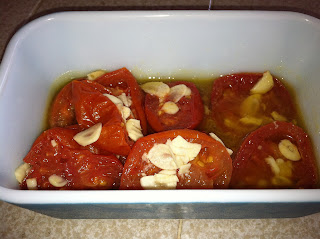 |
| Tomatoes, onions, garlic, oil, salt and pepper |
 |
| Roasted tomatoes |
 |
| Roasted tomatoes with bay leaves and stock |
 |
| Using an immersion blender |
 |
| Roasted Tomato Soup with cream and garnished with roasted grape tomato My plants bearing medium-large tomatoes are in full bloom. So with an abundance of tomatoes but not enough to can, Roasted Tomato Soup sounded good. When I Googled “roasted tomato soup”, this one sounded best to me. This is adapted from Tyler Florence’s recipe on www.foodnetwork.com. Roasted Tomato Soup Ingredients: 2 ½ lbs fresh tomatoes (mix of plum, heirloom grape) 6 cloves of garlic, crushed 2 small onions, sliced ½ C vegetable oil Salt and pepper 1 quart chicken or vegetable stock 2 bay leaves 4 tablespoons butter ½ C chopped fresh basil leaves (optional) ¾ C heavy cream (optional) Preheat oven to 450°F. Wash, core and cut the tomatoes into halves. Spread the tomatoes, garlic cloves and onions onto a baking tray. If using vine cherry tomatoes for garnish, add them as well, leaving them whole and on the vine. Drizzle with 1/2 cup of oil and season with salt and pepper. Roast for 20 to 30 minutes, or until caramelized. Remove roasted tomatoes, garlic and onion from the oven and transfer to a large stock pot (set aside the roasted vine tomatoes for later). Add 3/4 of the stock, bay leaves, and butter. Bring to a boil, reduce heat and simmer for 15 to 20 minutes or until liquid has reduced by about a third. Wash and dry basil leaves, if using, and add to the pot. Use an immersion blender to puree the soup until smooth. Return soup to low heat, adjust consistency with remaining stock, if necessary. Season to taste with salt and freshly ground black pepper. Garnish in bowl with a splash of heavy cream and 3 or 4 roasted vine cherry tomatoes. ********************** OMG! This was quite a revelation because up until a few years ago I was not fond of tomatoes, raw or cooked. Tomato soup sounded and looked like water-downed catsup, or tomato juice at best. But this soup! This soup was so rich and delicious!! My family and I couldn’t get enough of it. Roasting not only concentrates the flavor of the tomato but adds to it by way of caramelization. As I said above, this recipe is adapted from Tyler Florence’s recipe. For instance, I used vegetable broth instead of chicken broth. This did not make a difference in the flavor because the outcome was rich and robust. I also substituted sage for basil simply because I did not have basil. Therefore you can add practically any other herb you have on hand such as oregano, thyme, tarragon, etc. Just be sure to adjust the amount to your taste. And finally, I only added the cream as a garnish to maintain the soup’s tomato-ey color and flavor. If you don’t have an immersion blender, you can transfer the soup to a regular blender or food processor to puree it. Then transfer it back to the pot to finish cooking. Since I harvested more tomatoes the other day, and can’t possibly use them all, I roasted enough for 3 more batches of this soup. After cooling the roasted tomatoes I transferred them to a freezer-safe container. This way whenever I want Roasted Tomato Soup in the fall or winter, all I have to do is defrost a packet, add broth and finish off the recipe. This is a quick way to preserve my tomatoes without having to can them or take up a lot of freezer space. So when are you going to make this soup? |
































